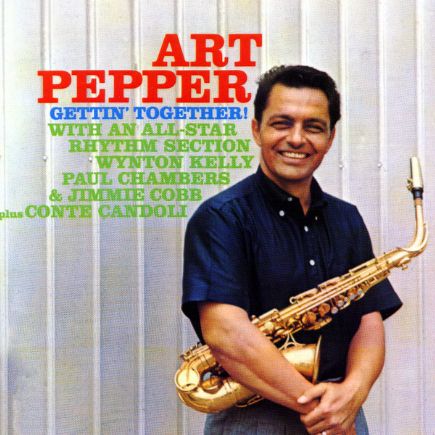Rhythm-a-Ning: l’esprit du bebop dans un clin d’œil à Monk
Composé en 1957 par Thelonious Monk, Rhythm-a-Ning est devenu un incontournable du répertoire bebop et post-bop. Son titre joue sur l’ironie et la rythmique: contraction probable de rhythm et thing-a-ning (un truc-qui-fait-ting ), il évoque déjà l’humour, la singularité et la démarche artisanale de Monk, figure centrale du jazz moderne.
Inspiré par un riff de Mary Lou Williams, amie de Monk, dans un arrangement de 1936 (Walking and Swinging), Rhythm-a-Ning est construit sur les grilles harmoniques de I Got Rhythm de George Gershwin, mais il en détourne l’usage à travers des accents déplacés, des silences signifiants et des accords asymétriques, typiques du langage monkien.
Au fil des décennies, Rhythm-a-Ning a été repris par une multitude d’artistes, devenant un terrain d’improvisation fertile, à la croisée de l’hommage et de l’invention. En jouant ce standard, les musiciens ne se contentent pas d’interpréter une composition: ils dialoguent avec l’esthétique de Monk, entre rigueur formelle et liberté expressive.
Art Pepper: le dialogue des mondes
Enregistrée à Los Angeles le 29 février 1960 pour l’album Gettin’ Together!, la version de Rhythm-A-Ning révèle un Art Pepper en pleine maturité artistique, à la croisée des influences de la côte Ouest et de la scène new-yorkaise. Entouré de Conte Candoli à la trompette, Wynton Kelly au piano, Paul Chambers à la contrebasse et Jimmy Cobb à la batterie, le saxophoniste, alternant ici entre alto et ténor, livre une interprétation d’une vitalité saisissante, à la fois ancrée dans le swing et traversée par l’esprit d’exploration cher à Thelonious Monk, compositeur du thème.
Dès les premières mesures, le ton est donné: Pepper entre dans la mélodie avec une assurance flamboyante, son phrasé incisif s’appuyant sur une articulation claire et un sens aigu de la dynamique. Son jeu, plus robuste qu’à ses débuts, conserve pourtant cette fragilité expressive qui fait sa signature.
Conte Candoli, fidèle à son style à la fois lyrique et nerveux, lui répond avec des lignes d’une grande limpidité, tandis que la section rythmique menée par Wynton Kelly installe un groove d’une précision élégante, vibrant d’une énergie souple et continue. Paul Chambers et Jimmy Cobb, partenaires habituels de Miles Davis, apportent à l’ensemble une cohésion magistrale.
Rhythm-a-Ning: el espíritu del bebop en un guiño a Monk
Compuesta en 1957 por Thelonious Monk, Rhythm-a-Ning se ha convertido en una pieza imprescindible del repertorio bebop y post-bop. Su título juega con la ironía y la rítmica: probable contracción de rhythm y thing-a-ning (una cosa-que-hace-ting), alude de inmediato al humor, la singularidad y el enfoque artesanal de Monk, figura central del jazz moderno.
Inspirada en un riff de Mary Lou Williams, amiga de Monk, presente en un arreglo de 1936 (Walking and Swinging), Rhythm-a-Ning se basa en las progresiones armónicas de I Got Rhythm de George Gershwin, pero las subvierte mediante acentos desplazados, silencios significativos y acordes asimétricos, característicos del lenguaje monkiano.
A lo largo de las décadas, Rhythm-a-Ning ha sido versionada por numerosos artistas, convirtiéndose en un terreno fértil para la improvisación, entre homenaje e invención. Al tocar este estándar, los músicos no se limitan a interpretar una composición: entablan un diálogo con la estética de Monk, entre rigor formal y libertad expresiva.
Art Pepper: el diálogo de los mundos
Grabada en Los Ángeles el 29 de febrero de 1960 para el álbum Gettin’ Together!, la versión de Rhythm-A-Ning revela a un Art Pepper en plena madurez artística, en la encrucijada entre las influencias de la Costa Oeste y la escena neoyorquina. Rodeado de Conte Candoli a la trompeta, Wynton Kelly al piano, Paul Chambers al contrabajo y Jimmy Cobb a la batería, el saxofonista, alternando aquí entre alto y tenor, ofrece una interpretación de vitalidad sorprendente, anclada en el swing y atravesada por el espíritu explorador de Thelonious Monk, compositor del tema.
Desde los primeros compases, el tono queda establecido: Pepper entra en la melodía con una seguridad deslumbrante, su fraseo incisivo apoyado en una articulación clara y un sentido agudo de la dinámica. Su interpretación, más robusta que en sus inicios, conserva sin embargo esa fragilidad expresiva que constituye su sello personal.
Conte Candoli, fiel a su estilo a la vez lírico y enérgico, responde con líneas de gran claridad, mientras la sección rítmica dirigida por Wynton Kelly establece un groove de precisión elegante, vibrante de una energía fluida y constante. Paul Chambers y Jimmy Cobb, compañeros habituales de Miles Davis, aportan al conjunto una cohesión magistral.
Rhythm-a-Ning: lo spirito del bebop in un cenno a Monk
Composta nel 1957 da Thelonious Monk, Rhythm-a-Ning è diventata un punto di riferimento del repertorio bebop e post-bop. Il titolo gioca con ironia e ritmo: probabile contrazione di rhythm e thing-a-ning (una cosina che fa ting), richiama immediatamente l’umorismo, l’originalità e l’approccio artigianale di Monk, figura centrale del jazz moderno.
Ispirata a un riff di Mary Lou Williams, amica di Monk, presente in un arrangiamento del 1936 (Walking and Swinging), Rhythm-a-Ning si fonda sulle progressioni armoniche di I Got Rhythm di George Gershwin, ma ne sovverte l’uso con accenti spostati, silenzi significativi e accordi asimmetrici, tutti tratti distintivi del linguaggio monkiano.
Nel corso dei decenni, Rhythm-a-Ning è stata reinterpretata da numerosi artisti, diventando un terreno fertile per l’improvvisazione, tra omaggio e invenzione. Suonando questo standard, i musicisti non si limitano a eseguire un brano: instaurano un dialogo con l’estetica di Monk, tra rigore formale e libertà espressiva.
Art Pepper: il dialogo dei mondi
Registrata a Los Angeles il 29 febbraio 1960 per l’album Gettin’ Together!, la versione di Rhythm-A-Ning rivela un Art Pepper nella piena maturità artistica, al crocevia tra le influenze della West Coast e la scena newyorkese. Circondato da Conte Candoli alla tromba, Wynton Kelly al pianoforte, Paul Chambers al contrabbasso e Jimmy Cobb alla batteria, il sassofonista, alternando qui tra alto e tenore, offre un’interpretazione di sorprendente vitalità, radicata nello swing e attraversata dallo spirito di esplorazione caro a Thelonious Monk, compositore del brano.
Fin dalle prime battute il tono è chiaro: Pepper entra nella melodia con una sicurezza fiammeggiante, il suo fraseggio incisivo sostenuto da un’articolazione limpida e da un acuto senso della dinamica. Il suo linguaggio, più vigoroso rispetto agli esordi, conserva tuttavia quella fragilità espressiva che ne costituisce la firma.
Conte Candoli, fedele al suo stile insieme lirico e nervoso, risponde con linee di grande chiarezza, mentre la sezione ritmica guidata da Wynton Kelly stabilisce un groove di elegante precisione, vibrante di un’energia flessibile e continua. Paul Chambers e Jimmy Cobb, abituali compagni di Miles Davis, apportano all’insieme una coesione magistrale.
Rhythm-a-Ning: the spirit of bebop in a nod to Monk
Composed in 1957 by Thelonious Monk, Rhythm-a-Ning has become a cornerstone of the bebop and post-bop repertoire. Its title plays with irony and rhythm—likely a blend of rhythm and thing-a-ning (a kind of thing-that-goes-ting)—and immediately evokes Monk’s humor, singularity, and handcrafted approach as a central figure of modern jazz.
Inspired by a riff from Mary Lou Williams, a close friend of Monk’s, featured in a 1936 arrangement (Walking and Swinging), Rhythm-a-Ning is built on the harmonic framework of George Gershwin’s I Got Rhythm, but twists it through displaced accents, meaningful silences, and asymmetrical voicings—all trademarks of Monk’s musical language.
Over the decades, Rhythm-a-Ning has been interpreted by a wide range of artists, becoming a fertile ground for improvisation, blending tribute and invention. By playing this standard, musicians do more than perform a composition: they engage in a dialogue with Monk’s aesthetic, balancing formal rigor and expressive freedom.
Art Pepper: the dialogue of worlds
Recorded in Los Angeles on February 29, 1960, for the album Gettin’ Together!, the version of Rhythm-A-Ning reveals Art Pepper in full artistic maturity, standing at the crossroads of West Coast influences and the New York scene. Surrounded by Conte Candoli on trumpet, Wynton Kelly on piano, Paul Chambers on bass, and Jimmy Cobb on drums, the saxophonist—switching here between alto and tenor—delivers a performance of striking vitality, rooted in swing yet infused with the spirit of exploration so dear to Thelonious Monk, composer of the piece.
From the very first bars, the tone is set: Pepper enters the melody with blazing confidence, his incisive phrasing supported by clear articulation and a keen sense of dynamics. His playing, more robust than in his early years, nevertheless retains that expressive fragility that defines his voice.
Conte Candoli, true to his lyrical yet fiery style, responds with lines of great clarity, while the rhythm section led by Wynton Kelly lays down an elegantly precise groove, vibrant with supple and sustained energy. Paul Chambers and Jimmy Cobb, long-time partners of Miles Davis, bring to the ensemble a masterful sense of cohesion.


